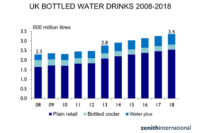U.S. consumption of bottled water shows continued growth
Consumption increases 6.2% in 2012; Sales up 6.7%.

The International Bottled Water Association (IBWA, www.bottledwater.org), in conjunction with Beverage Marketing Corporation (BMC, www.beveragemarketing.com) has released 2012 bottled water statistics, compiled by BMC, a research, consulting, and financial services firm dedicated to the global beverage industry. The new BMC data show that the overall consumption of bottled water increased by 6.2% and bottled water sales were up 6.7%.
In 2012, total U.S. bottled water consumption increased to 9.67 billion gallons, up from 9.1 billion gallons in 2011. In fact, 2012’s consumption growth was the strongest it has been in five years. In addition, per-capita consumption is up 5.3% in 2012, with every person in America drinking an average of 30.8 gallons of bottled water last year. Bottled water increased in absolute volume more than any other beverage category in the U.S.
Bottled water sales increased by 6.7% in 2012, and now total $11.8 billion.
According to Gary Hemphill, managing director, information services, at BMC, “All signs point to U.S. consumers’ already displayed thirst for bottled water continuing in the years ahead. Changes in per capita consumption indicate persistent interest in a product that consumers embrace as a healthful alternative to other beverages.”
“Indeed, bottled water added more gallons to its per-person consumption rate in ten years than either ready-to-drink tea or sports beverages reached by the end of that period,” he added. “In fact, neither even reached five gallons per U.S. consumer by 2012. Bottled water proved itself to be not only a key component of the liquid refreshment beverage market; it also proved itself to be poised for future increases in per capita consumption.”
“People choose bottled water for a variety reasons,” says Joe Doss, IBWA’s president and CEO. “Many consumers are focusing on healthful choices for themselves and their families, and they know that safe, convenient, refreshing bottled water has zero calories and is the healthiest option on the shelf. They also appreciate the reliable, consistent quality of bottled water. And, despite continued efforts by some activist groups to discourage people from drinking bottled water, consumption and sales of this healthy product are increasing as consumers make their voices heard in the marketplace.”
Bottled water is comprehensively regulated at both the federal and state level. It is regulated as a food product by the U.S. Food and Drug Administration (FDA) and the FDA regulations governing the safety and quality of bottled water must be at least as stringent as the Environmental Protection Agency (EPA) standards for tap water. And, in some very important cases like lead, coliform bacteria, and E. coli, bottled water regulations are substantially more stringent.
The bottled water industry is utilizing a variety of measures to continue reducing its environmental footprint. All bottled water containers are 100% recyclable and many bottled water companies are already using recycled plastic in their bottles. Some are already producing 100% recycled PET bottled water containers. Although bottled water makes up only 0.03% of the U.S. waste stream, according to the EPA, the bottled water industry works hard on a number of fronts with recycling advocates, communities, and our beverage and food partners to increase recycling rates. In fact, between 2000 and 2011, the average weight of a 16.9-ounce (half-liter) PET plastic bottle has declined 47.7% to 9.89 grams. This has resulted in a savings of 3.3 billion pounds of PET resin since 2000. Now at 38.6%, the recycling rate for single-serve PET plastic bottled water containers has more than doubled in the last seven years, and PET plastic bottled water containers are the most frequently recycled PET beverage container in curbside recycling programs.
The significant increase in the recycling rate of PET plastic bottled water containers, coupled with the continuing decrease in container weight, underscores the consistent drive of the bottled water industry to improve recycling programs and reduce its overall environmental footprint.
Looking for a reprint of this article?
From high-res PDFs to custom plaques, order your copy today!






